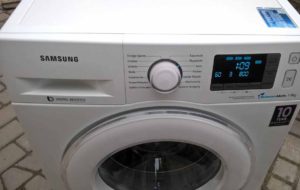 Washing machines from the Korean company Samsung are of good quality and durability. A household appliance can fail only if there is excessive wear on the main parts or when the device is used in violation of the rules. If a breakdown occurs, Samsung washing machines can be repaired on your own. How to restore the device with your own hands will be described in detail in this article.
Washing machines from the Korean company Samsung are of good quality and durability. A household appliance can fail only if there is excessive wear on the main parts or when the device is used in violation of the rules. If a breakdown occurs, Samsung washing machines can be repaired on your own. How to restore the device with your own hands will be described in detail in this article.
Frequent causes of breakdowns
Malfunctions of Samsung washing machines can number in the hundreds, but first of all, if the device malfunctions, the following “pathologies” should be excluded:
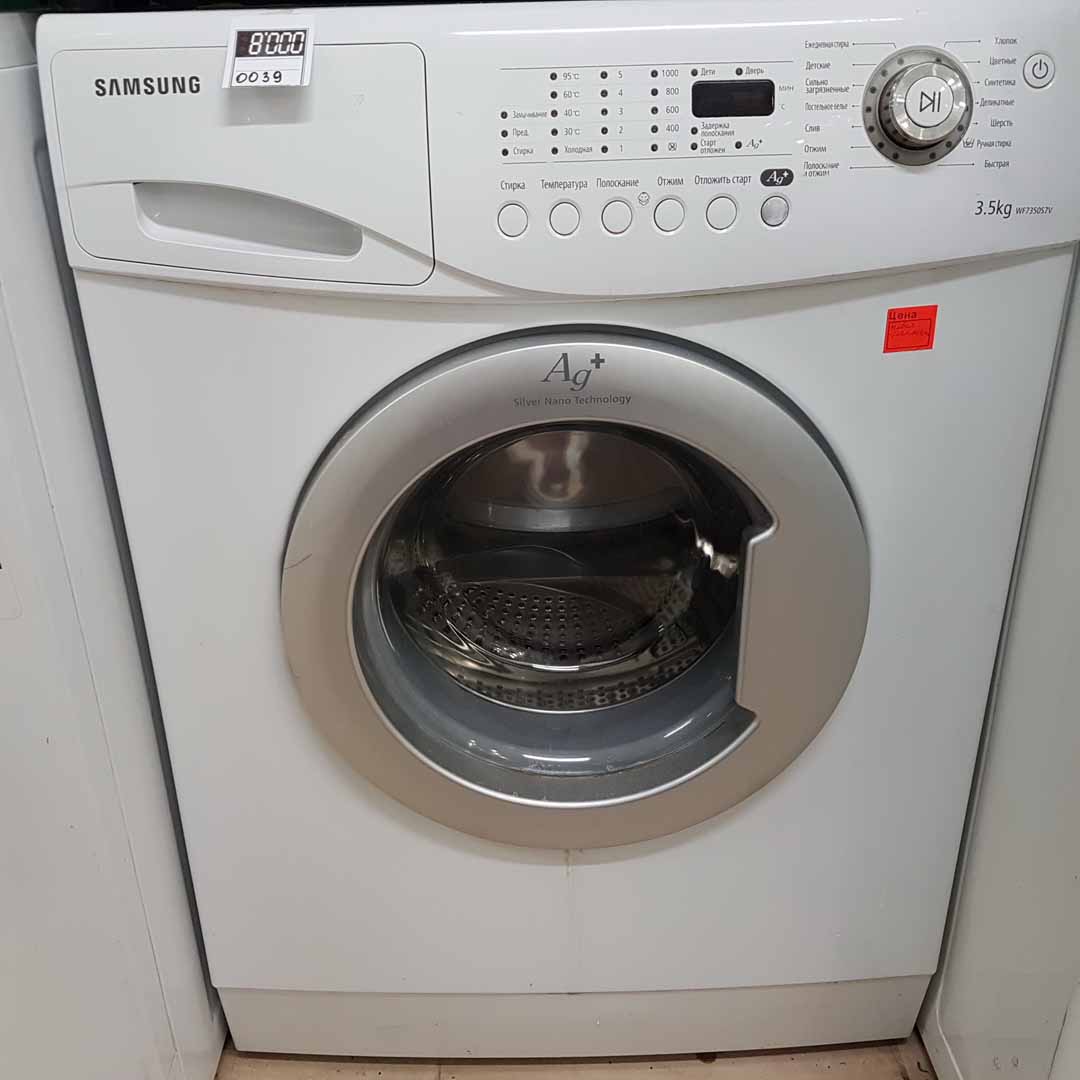
- Worn or broken drive belt.
- Burnout of the internal resistance of the heating element.
- Inlet valve faulty.
- Drain pump failure.
- Bearing jamming.
- Electronics malfunction.
Electronic components are quite resistant to power surges and excessive vibration, so technicians very rarely deal with this type of malfunction. The most common failures in washing machines are drive belts, heating elements and water drainage devices. These malfunctions will be discussed in detail below.
Replacing the heating element
If the heating element in a washing machine breaks down, the main sign of such a malfunction is a deviation in the temperature regime of the device. Some models can forcefully stop the work process, and the error code “H1” will appear on the display. The reason why the heating element of a washing machine fails is typical for any water heating element.
If the water supplied to the device has a high degree of hardness, then scale will form when the liquid is frequently heated to a high temperature. With a significant layer of deposits, the efficiency of the heating element decreases, and the heating element itself fails as a result of excessive heating of the internal resistance. If the heating element is burnt out, you will need to replace it with a known good element, which is intended for use only in a specific model of household appliance.
The process of replacing the heating element is carried out in the following order:
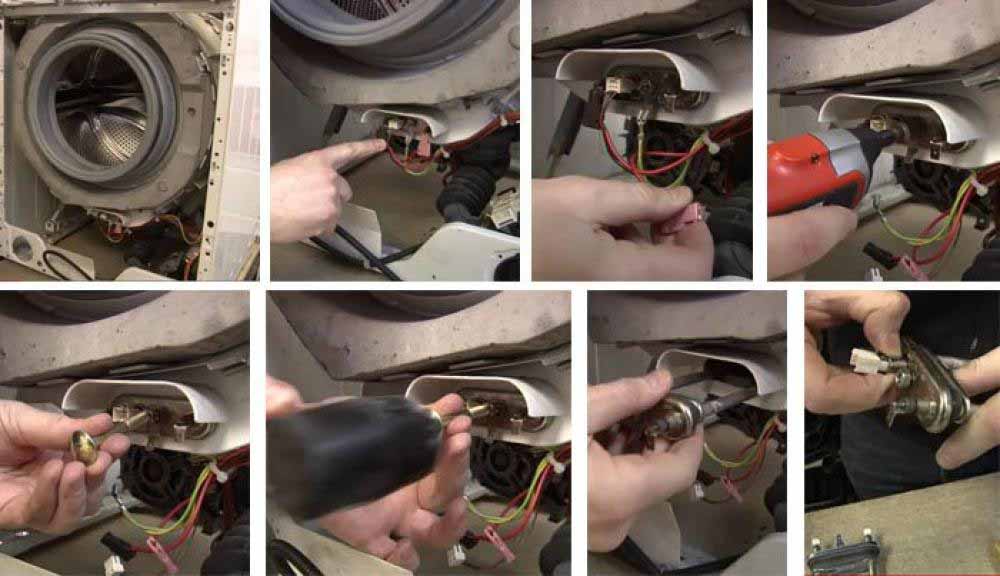
- Remove the front panel of the device.
- Remove the faulty element.
- Install a new heating element.
- Assemble the washing machine.
A feature of dismantling the heating element of Samsung washing machines is the need to remove the front wall of the household appliance. Despite the fact that to access the heating element it will be necessary to remove a significant number of elements and mechanisms, the good news for the amateur craftsman is that there is no need to move the device or disconnect it from communications.
The front panel is removed in the following sequence:
- Unscrew the drain filter and drain the water.
- Remove the dispenser and unscrew the 2 bolts.
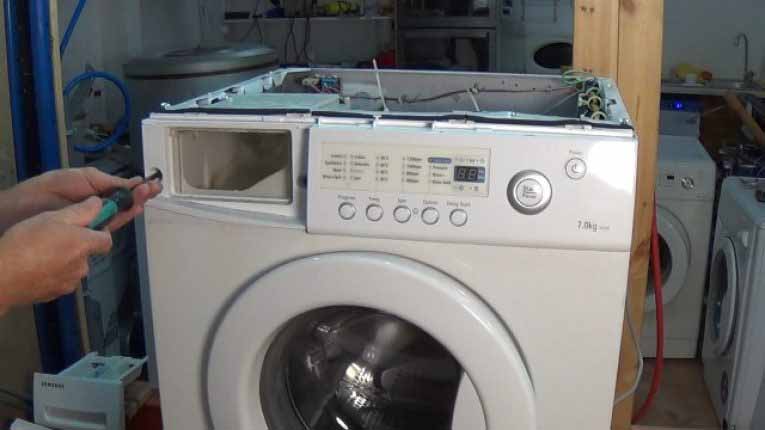
- Unscrew the bolt on the control panel.
- Without removing the control panel, move it to the side.
- Turn the rubber cuff of the loading hatch into the drum.
- Remove the bottom panel.
- Unscrew the 4 fasteners located behind the bottom panel.
Now you can remove the front panel, behind which the heating element of the device is located. Before you begin removing the heating element, it is recommended to check it with a multimeter. To do this you need:
- Turn on the device and switch it to resistance measurement mode up to 200 Ohms.
- Disconnect the wires from the temperature sensor.
- Connect the positive probe of the multimeter to one contact of the heating element, and the negative probe to the second.
If there is no resistance at all, the heating element must be replaced.
Removal of the faulty element is carried out in the following order:
- Using a socket wrench, unscrew the nut located between the contacts of the heating element.
- Grasping both contacts, carefully loosen the heating element.
- Push the stud onto which the nut was screwed using a hammer or socket wrench.
- Pry off the heating element with a screwdriver.
- Pull the contacts and remove the heating element from the groove.
Installation of a new heating element is carried out in the following sequence:
- Check the new element with a multimeter.
- Lubricate the seal with machine oil.
- Install a new element.
- Install a temperature sensor.
- Connect the wires to the terminals.
After installing the heating element, the front panel is assembled in the reverse order of removal.
Drain pump repair
The pump of a Samsung washing machine also often fails. This breakdown will definitely not allow you to complete the laundry program, so before you begin to solve the problem, you need to remove the water from the washing machine. Drain liquid from a faulty household appliance in the following sequence:
- Disconnect the washing machine from the 220 V network.
- Prepare a flat container for water and old rags.
- Remove the drain hose from the sewer pipe.
- Place the end of the hose into the prepared container.
After the water has completely drained, you can begin to remove the pump from the washing machine. The pump is removed in the following order:
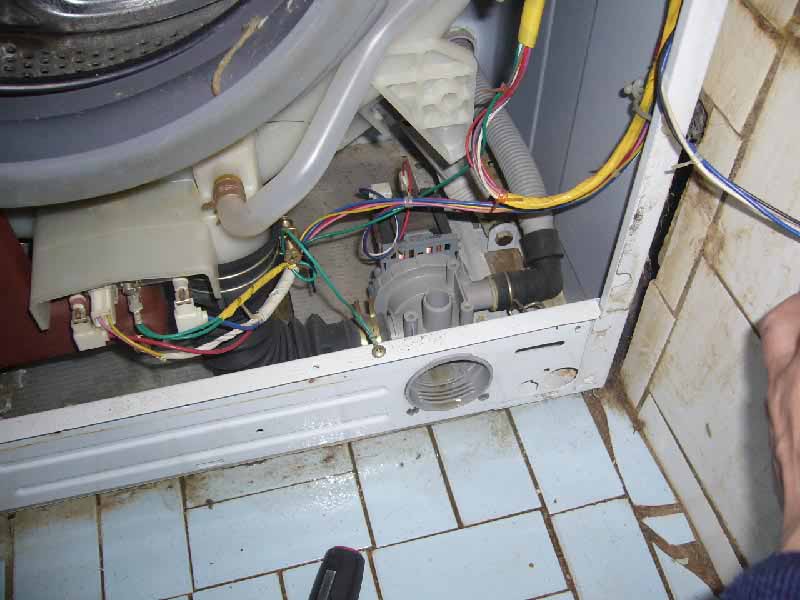
- Unscrew the hose clamp on the back wall of the washing machine.
- Remove the 2 screws at the bottom of the front cover of the device.
- Tilt the washing machine backwards.
- Bend down the lower protective cover.
- Disconnect the electrical wire terminals.
- Unscrew the 4 screws securing the volute to the pump.
- Remove the pump.
If the drain pump malfunctions, it is not always necessary to install a new part. Very often, the cause of pump inoperability is threads wound around its blades, pieces of wool or other objects that may be located on the pump motor shaft. This problem can be resolved very simply. To do this, simply remove the pump impeller and clean it of contamination. You should also remove any wound objects from the motor shaft.
After installing the impeller on the shaft and checking the motor with a multimeter, you can assemble the pump. To check the electric motor, it is necessary to measure the resistance between the terminals. If this parameter is completely absent, then you need to purchase a new pump. For replacement, only the original model should be used.

Checking the drain pump with a multimeter
The pump is installed in the reverse order of removal. After all work is completed, the operation of the washing machine is checked. For this purpose, a test run of the device is carried out in rinsing mode.
When starting up for the first time, you should carefully inspect the household appliance for possible leaks.
Replacing the drive belt
When operating a washing machine with a faulty drive belt, increased noise will be observed during all cycles of operation of the washing machine. Visually, this breakdown can be determined by a significant decrease in the drum rotation speed. It is also possible that the washing machine will completely stop operating as a result of a frayed belt wrapping around the electric motor pulley.

To install a new drive belt on a Samsung washing machine, you must follow these instructions:
- Disconnect the household appliance.
- Unscrew the screws holding the back cover.
- Remove the back cover.
- Carefully pry off the belt with a screwdriver.
- Bend the belt to the side and turn the pulley half a turn.
- Remove the faulty belt.
- Place a new belt on the electric motor pulley.
- Place the belt over half the diameter of the driven pulley.
- Rotate the driven pulley 1 revolution.
- Install the back cover of the washing machine.
If all the recommendations were followed correctly, then after replacing the belt the device will operate normally.
Intake valve repair
The inlet valve of the washing machine functions as a shut-off device, which allows you to collect the required amount of water for washing and rinsing clothes.
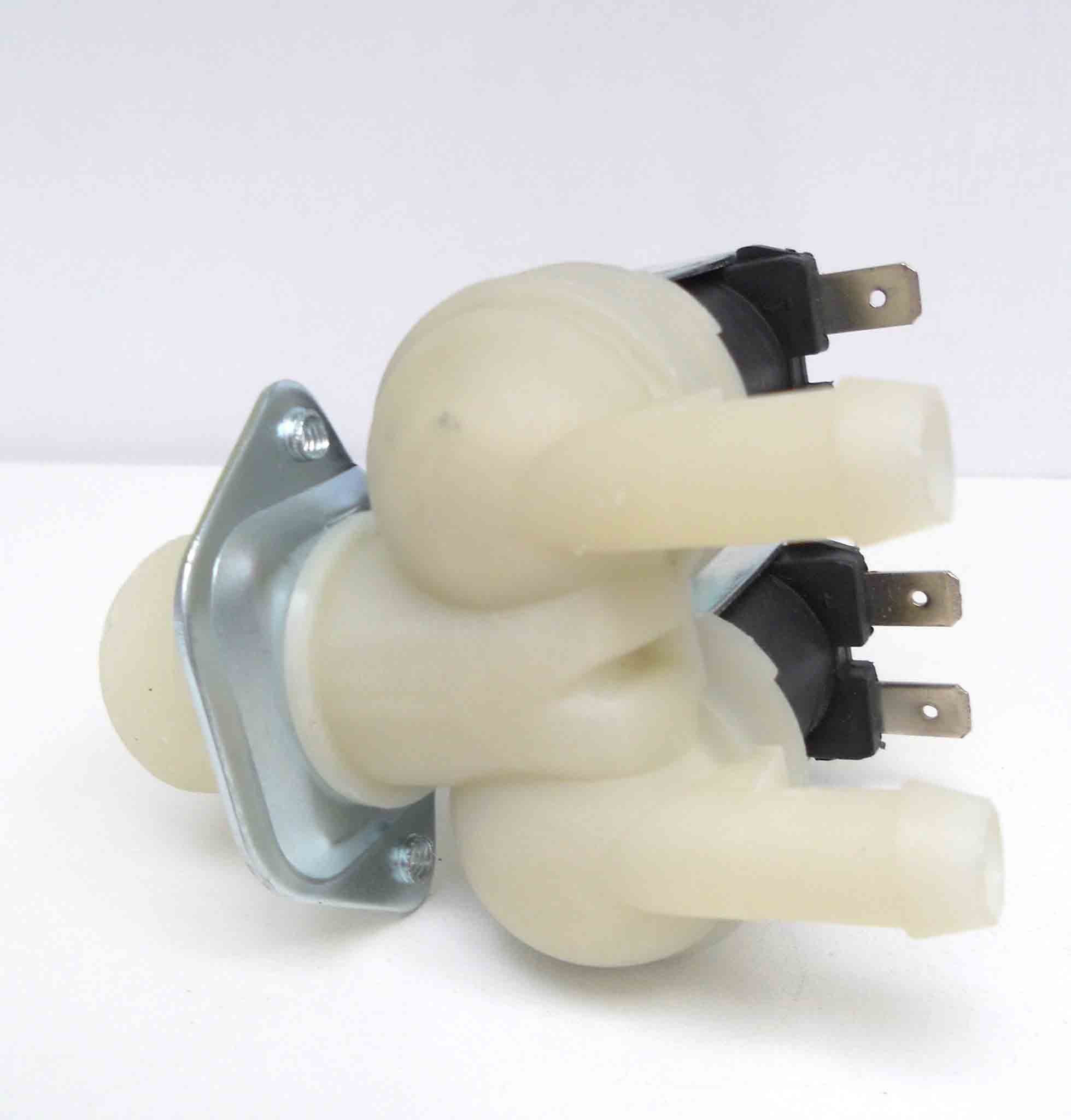
The principle of operation of the inlet valve is based on the movement of the valve as a result of the supply of current to the electromagnetic coil of the device, so most often this failure is manifested by a lack of fluid collection. If the coil is faulty or there is a break in the electrical network of the wires connected to it, the valve will not open.Repairing the filler shut-off device with your own hands is not difficult.
The solenoid valve cannot be repaired, therefore, if problems related to the performance of the part are identified, it is necessary to replace the product. The new device must not only be in working order, but also ideally suitable for use with a specific model of washing machine. To replace the solenoid valve you must:
- Unplug the washing machine.
- Remove the back cover.
- Disconnect the fill valve from the pipes and electrical wires.
- Remove the defective part.
- Install the new valve, connecting the pipes and electrical terminals.
After checking the functionality of the inlet valve, the washing machine can be operated without any restrictions.
Replacing bearings
The main diagnostic sign of faulty drum bearings in a Samsung washing machine is the presence of grinding and noise in all modes of operation of the device. Before you begin troubleshooting the problem yourself, you should make sure that the cause of the unstable operation of the device is the failure of these particular parts.

First, you should inspect the drum for possible detection of foreign objects. If there are no “foreign bodies”, you must press the bottom of the drum. If the plane of the part deviates significantly, this will indicate that there is play in the bearings. Self-repair of Samsung washing machines with faulty drum bearings is also possible, but if you have doubts about your own abilities, then the most correct solution would be to contact a specialized workshop.
If you decide to do the repair yourself, you should know in advance that to fix the problem you will need to completely disassemble the washing machine. In order not to be distracted by searching for the necessary tools during the work process, it is recommended to prepare in advance everything necessary to perform this type of repair. To replace the washing machine drum bearings you will need:
- Wrenches, socket and hex keys.
- Pliers.
- Small hammer.
- Engine oil.
- Slotted and Phillips screwdriver.
- Sealant.
- Hairpin.
The process of self-repair begins with removing the drum from the washing machine; for this you need to:
- Disconnect the washing machine from the electrical network and other communications.
- Install the device on a level surface so that the device is accessible from 4 sides.
- Remove the top cover. To do this, you need to unscrew 2 screws on the back wall of the device, then pull the cover towards you and then up.
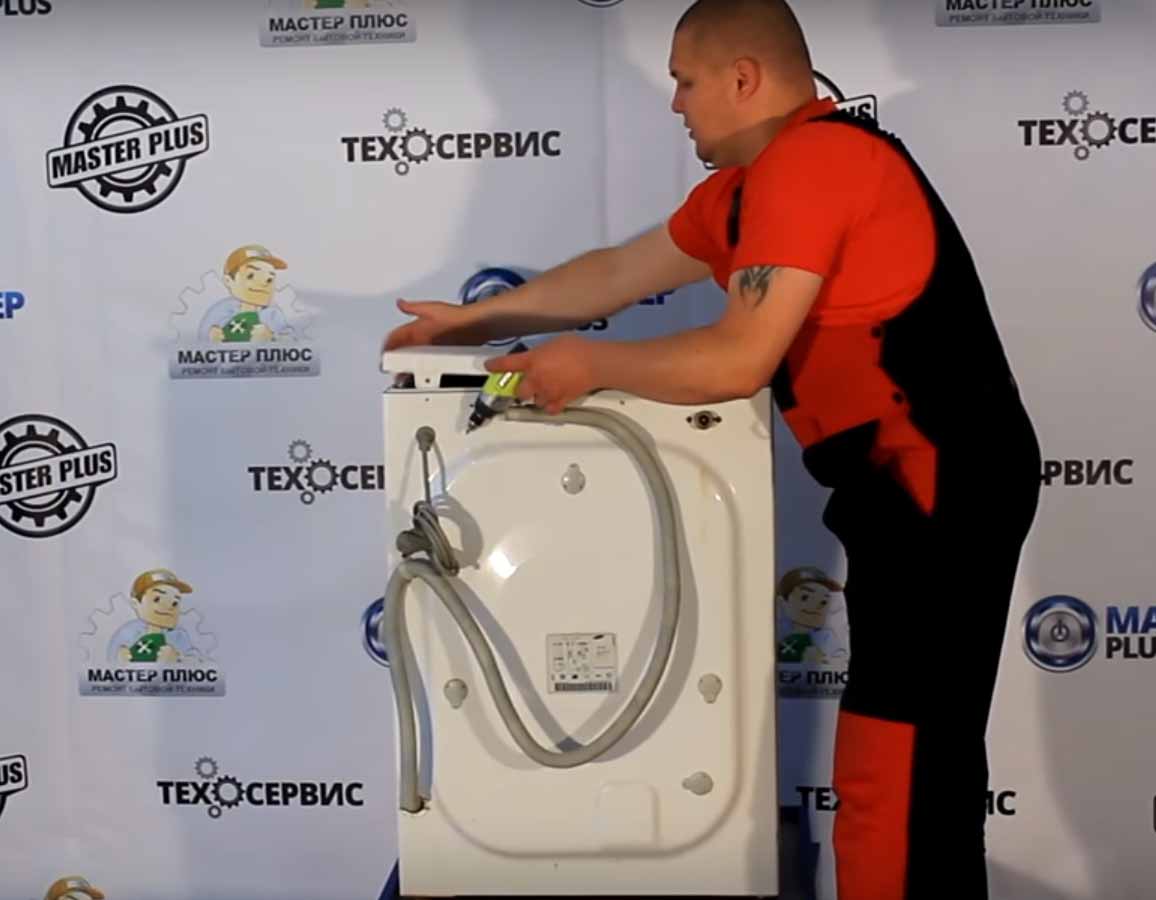
- Remove tray. To perform this operation, just pull the washing powder receiver towards you, then press the central valve, and then pull the tray again, pressing it from below with your second hand.
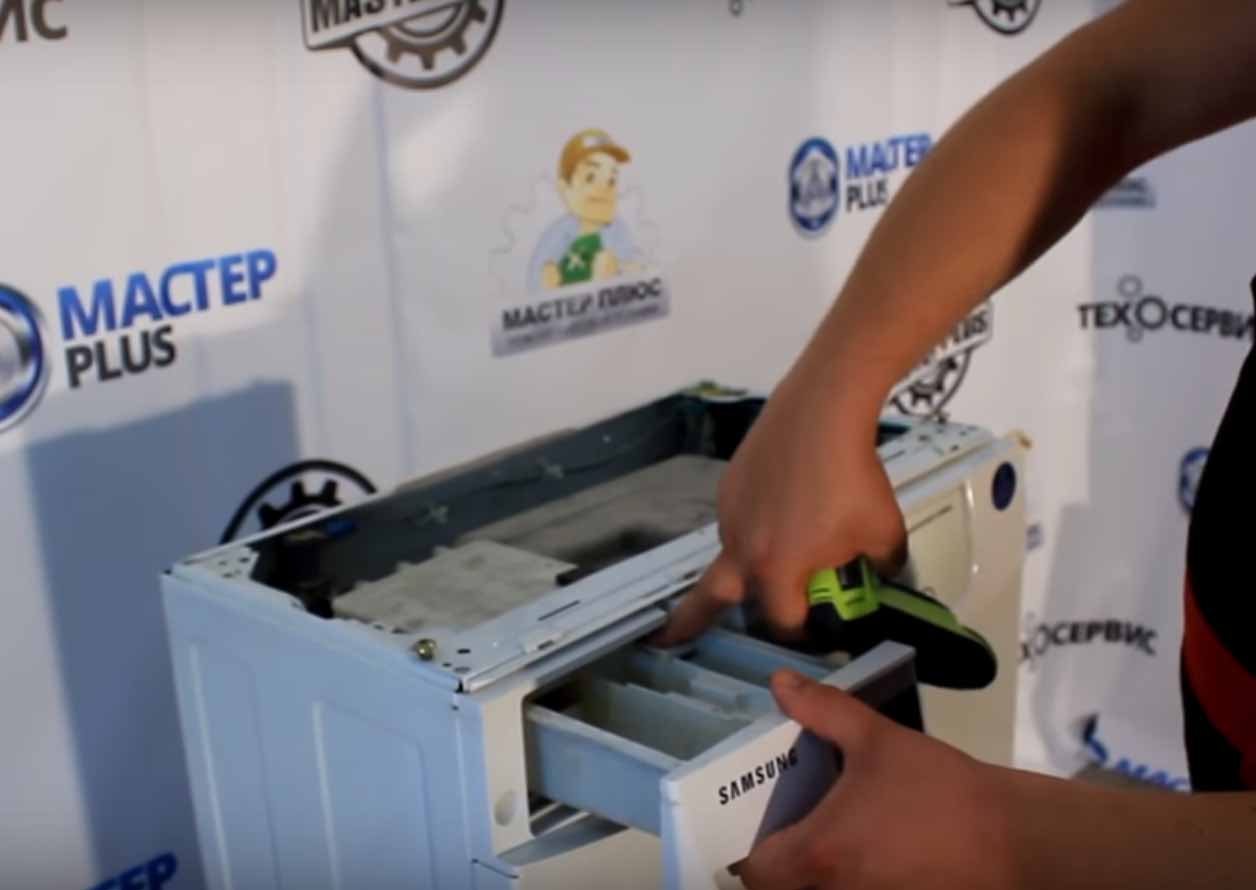
- Unscrew the hoses through which water is supplied and removed from the tray.
- Remove counterweight. For this purpose, it is enough to unscrew 3 bolts and pull this part up, being careful.

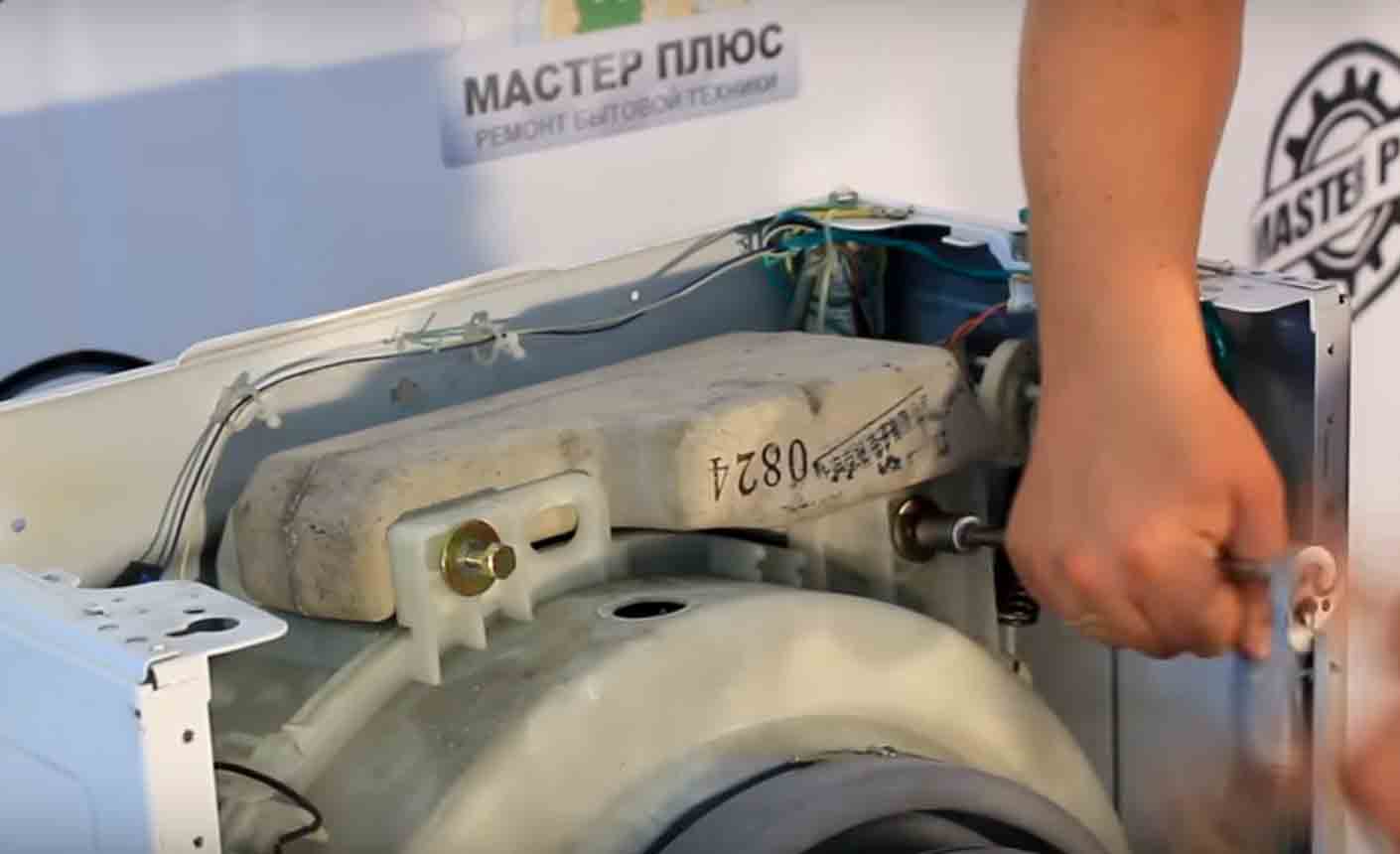
- Remove the rubber seal from the hatch. To perform this operation, you will need to remove the hatch latch, which is attached to the body of the washing machine. Then remove the sensor and the wire clamp holding the cuff, and then remove the rubber seal by pulling it towards you.
- Remove the bottom of the washing machine.To remove the bottom cover, you will need to lay the device on its side, and then unscrew the 4 screws holding this part.
- Remove the drum motor. To remove this part, simply unscrew the screws holding it and disconnect the wires. To avoid problems when assembling the device, it is recommended to mark all disconnected wires with a marker.
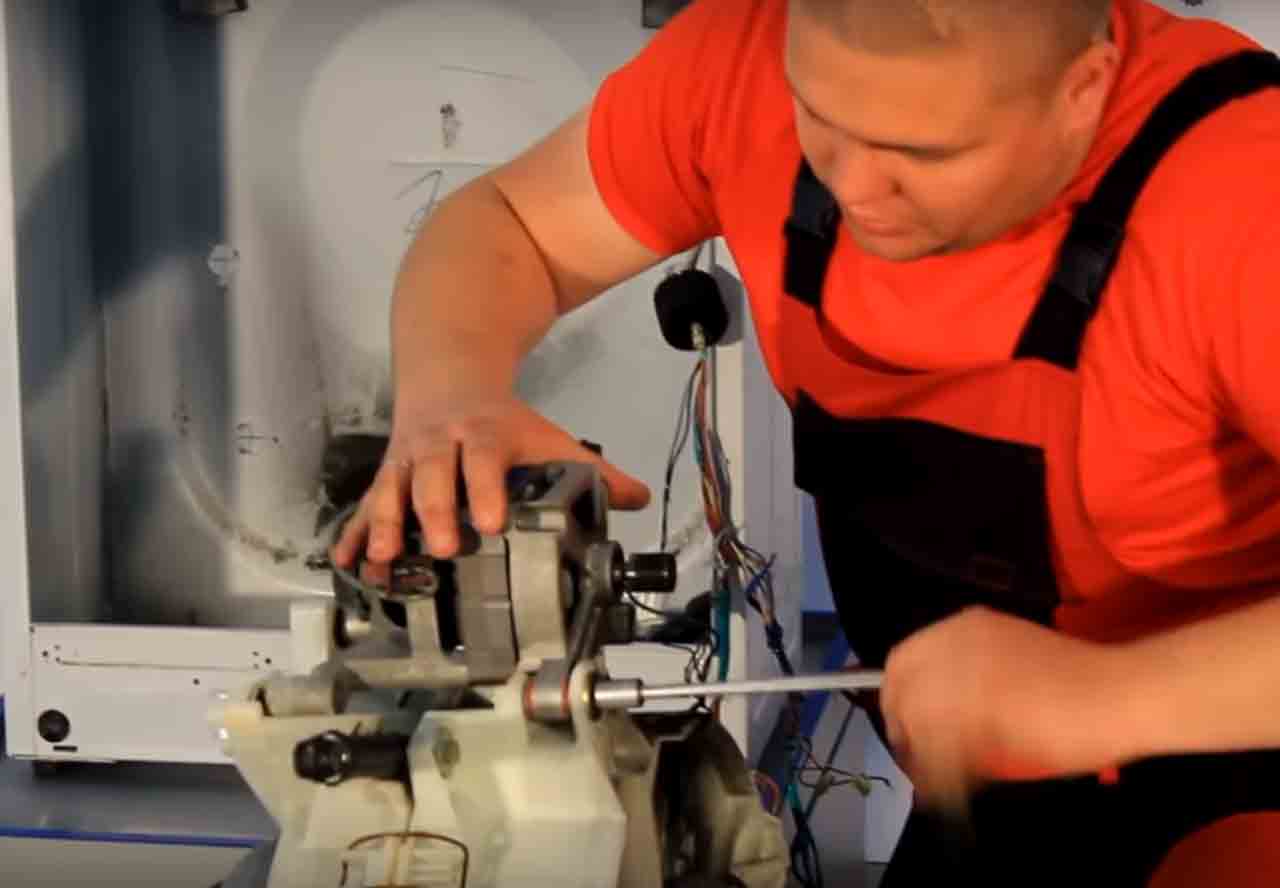
- Remove the drain pump. To perform this operation, simply unscrew the screws, disconnect the wires and remove the pipes.
- Remove the stands holding the drum.
- Unscrew the water fill valve.
- Remove the 4 springs holding the tank.
- Unscrew the front cover after removing the control panel.
- Remove the tub from the washing machine.
Now, in order to get the faulty bearings, you will need to disassemble the tank. This work must be done in the following order.
- Using a hexagon, unscrew the pulley.
- Remove staples and clips.
- Remove the upper part of the tank housing.
Now access to the drum will be completely open, which will allow us to proceed to the final stage of repairing the washing machine bearings. These parts are replaced in the following sequence:
- Knock out the large drum bushing bearing. A pin and a hammer should be used for this purpose. Impacts should be applied from the outside, being careful not to damage the bearing seat.
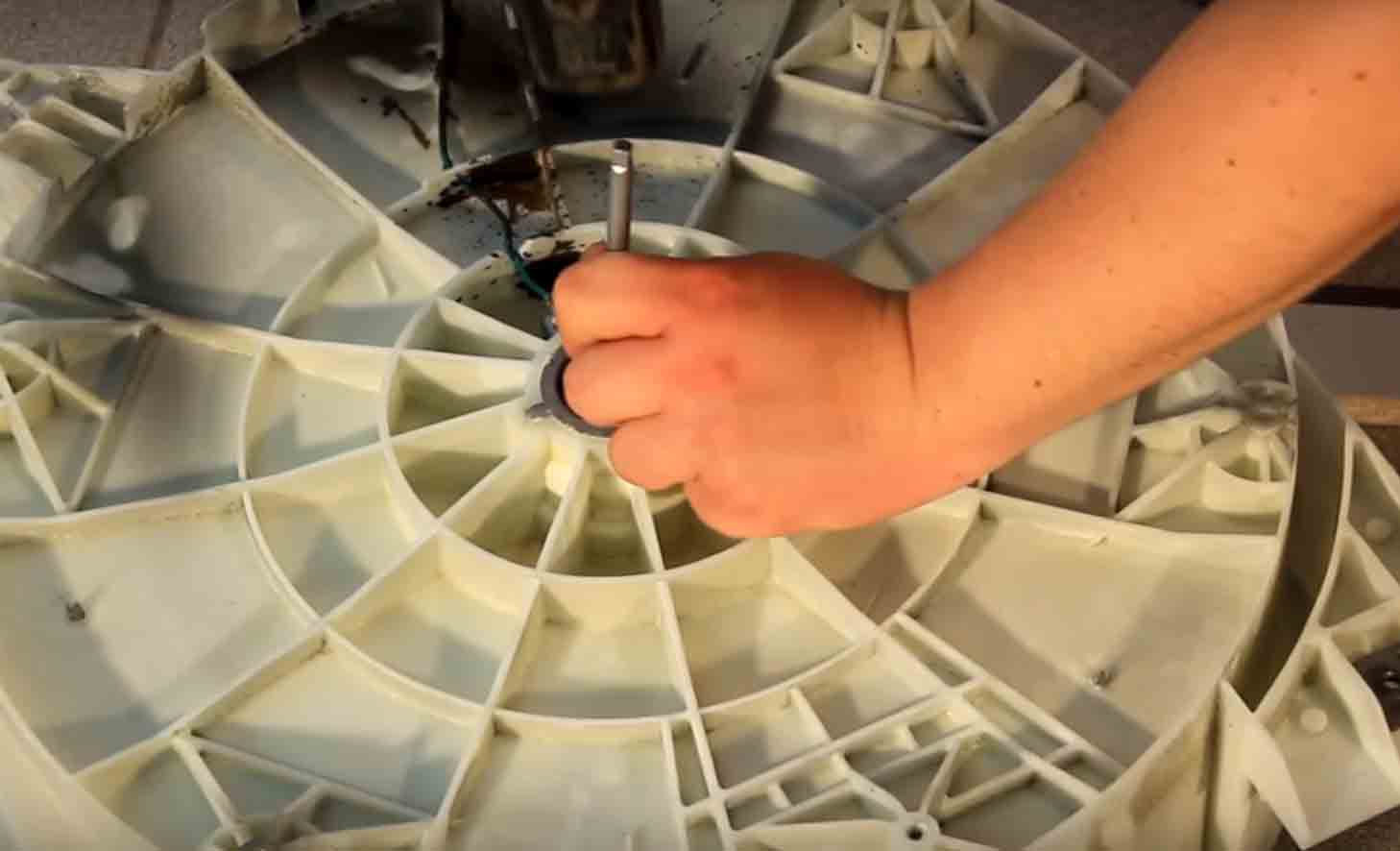
- The smaller diameter bearing is knocked out from the inside of the drum.
- Replace bearing seals.
- Lubricate the new oil seals with machine oil.
- Install new bearings.
It is recommended to press the bearings using a wooden spacer to reduce the likelihood of damage to this part.
After installing new parts, the washing machine is assembled in the reverse order.In this case, special attention should be paid to the torque of screw connections and the correct connection of wires. When replacing the drum bearings of Samsung washing machines, it is also recommended to pay attention to the condition of other parts of the device. First of all, you should clean the electric heating element from scale, inspect the condition of the drive belt and drain pump. If significant wear is detected, you should not wait for them to fail, but replace the parts during the repair of the washing machine bearings.
Conclusion
Repairing a Samsung washing machine, regardless of the complexity of the breakdown, requires careful handling of the internal parts of the device. Equally important is the correct connection of the pipes, because if the electronics are flooded with water, expensive repairs will be required, which cannot be carried out independently.









